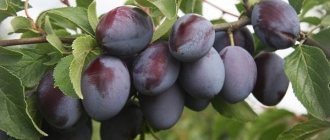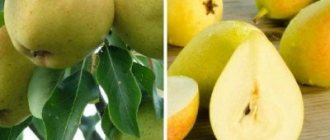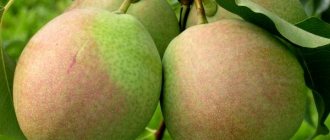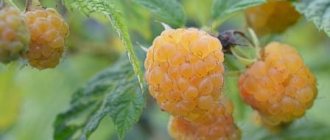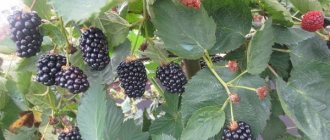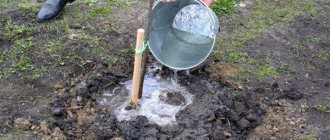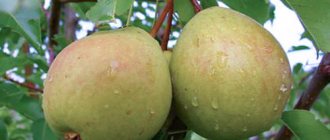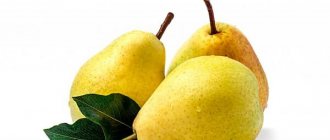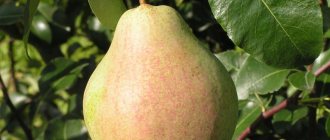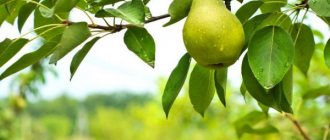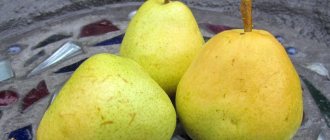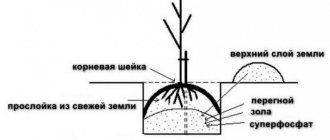Gardening » Pear
0
1608
Article rating
Kira Stoletova
Santa Maria pear is an early autumn variety. The tree is resistant to cold, and the fruits have a delicate sweet taste. In the article we will consider the description of the variety, the rules of planting and caring for it.
Characteristics of the Santa Maria pear variety
PEAR "SANTA MARIA, rootstock - pear, 2 years"
Bred by A. Moretinni by crossing the varieties Duchess Summer and Coscia.
The tree is medium-sized, early-fruiting, productive.
Winter-hardy, scab-resistant.
The fruits are large, weighing 200-230 g, elongated pear-shaped, with a diffuse pink blush.
The pulp is yellow-white, juicy, tender, oily, without granulations, with a pleasant dessert taste.
Autumn variety. Harvesting maturity occurs in mid-September. Stores in the refrigerator for 1-2 months.
ADVANTAGES: winter hardiness, early fruiting, productivity.
• — Are you interested in this variety? Do you need more information? We are ready to answer your questions.
Write! Call! Consultation hours from 9:00 to 19:00
Please pay attention!
The first 20-25 days
are key in terms of importance for the rooting of plants in a new place . The survival rate of young trees and shrubs in a new location and their further development largely depend on timely pruning and regular watering in the first three weeks.
Trimming.
Mandatory pruning
is recommended for fruit plants When planting, carry out post-planting pruning, leaving shoots no more than 40-45 cm long. It is also recommended to
annually
remove dry, damaged or fattening shoots, thinning, and crown formation.
Watering.
Young plants REQUIRE
regular , proper watering.
For successful rooting of the plant, it is important that the soil is wetted not only from above (by 7-12 cm), but to the depth of the tips of the roots of the seedling (up to 35-45 cm).
To do this, after planting during the first month
, you must water the plant 2 times a week, 1 bucket per tree.
In dry times, it is recommended to increase watering to 1.5-2 buckets of water per plant 2-3 times a week. Mulching.
To preserve moisture in the soil for a long time, it is advisable to use organic mulching of the tree trunk circle with a layer of 7-10 cm.
Loosening.
Regular, shallow.
Weeding around the tree trunk. Important to remember!
Lack of pruning during planting and irregular or insufficient watering in the first months after planting significantly reduce the percentage of plant survival in a new location.
Unsecrets of Divosad.
1. Planting dates. To achieve successful survival of seedlings, the sequence of actions is quite simple - first, a cold snap in nature, then, as a consequence, leaf fall and the transition of plants to the dormant stage, and it is during this period of cold weather and leaf fall that the seedlings are transplanted. but not in reverse order. So, cold snap to +10°C and below → stopping sap flow → replanting plants. 2. A common mistake is irregular watering. Regular watering after planting is one of the most important non-secrets for the survival of young plants.
Good luck with your choice.
Welcome to the world of Divosad on
Facebook!
!
Dear guest! We invite you to join our group of amateur gardeners on Facebook under the same name Divosad
.
Receive in the Divosad group
not only free consultations, promotions, exchange of experience and support for caring for your plants, but also a friendly circle of friends, like-minded people and a charge of positive emotions.
We really want our group to be cozy and exciting for everyone who loves gardening, roses, ornamental plants and berry crops.
Pear Simply Maria: variety description, planting and care, pollinators, photos, reviews
Bred by A. Moretinni by crossing the varieties Duchess Summer and Coscia.
The tree is medium-sized, early-fruiting, productive.
Winter-hardy, scab-resistant.
The fruits are large, weighing 200-230 g, elongated pear-shaped, with a diffuse pink blush.
The pulp is yellow-white, juicy, tender, oily, without granulations, with a pleasant dessert taste.
Autumn variety. Harvesting maturity occurs in mid-September. Stores in the refrigerator for 1-2 months.
ADVANTAGES: winter hardiness, early fruiting, productivity.
• — Are you interested in this variety? Do you need more information? We are ready to answer your questions.
Write! Call! Consultation hours from 9:00 to 19:00
Please pay attention!
The first 20-25 days are key in terms of importance for the rooting of plants in a new place.
after planting the seedlings in a permanent place. The survival rate of young trees and shrubs in a new location and their further development largely depend on timely pruning and regular watering in the first three weeks.
Trimming.
Mandatory pruning is recommended for fruit plants
When planting, carry out post-planting pruning, leaving shoots no more than 40-45 cm long. It is also recommended
annual
removal of dry, damaged or fattening shoots, thinning, crown formation.
Watering.
Young plants REQUIRE
regular proper watering.
For successful rooting of the plant, it is important that the soil is wetted not only from above (by 7-12 cm), but to the depth of the tips of the roots of the seedling (up to 35-45 cm). To do this, after landing
within the first month
, it is necessary to water the plant 2 times a week, 1 bucket per tree. In dry times, it is recommended to increase watering to 1.5-2 buckets of water per plant 2-3 times a week.
Mulching.
To preserve moisture in the soil for a long time, it is advisable to use organic mulching of the tree trunk circle with a layer of 7-10 cm.
Loosening.
Regular, shallow. Weeding around the tree trunk.
Important to remember!
Lack of pruning during planting and irregular or insufficient watering in the first months after planting significantly reduce the percentage of plant survival in a new location.
Unsecrets of Divosad.
1. Planting dates.
To achieve successful survival of seedlings, the sequence of actions is quite simple - first, a cold snap in nature, then, as a consequence, leaf fall and the transition of plants to the dormant stage, and it is during this period of cold weather and leaf fall that the seedlings are transplanted.
but not in reverse order. So, cold snap to +10°C and below → stopping sap flow → replanting plants. 2. A common mistake is irregular watering. Regular watering after planting is one of the most important non-secrets for the survival of young plants.
Good luck with your choice.
Welcome to the world of Divosad online
!
!
Dear guest! We invite you to join our online group of amateur gardeners under the same name Divosad
.
Receive in the Divosad group
not only free consultations, promotions, exchange of experience and support for caring for your plants, but also a friendly circle of friends, like-minded people and a charge of positive emotions.
We really want our group to be cozy and exciting for everyone who loves gardening, roses, ornamental plants and berry crops.
Secrets of successful cultivation
Regardless of the region of cultivation, the basic activities for growing pears are standard. Compliance with some nuances in the process of caring for fruit trees allows you to get the best results and a high yield of quality fruits:
- Pear plants adapt relatively easily to acidic and slightly acidic soils, but they absolutely cannot tolerate an increased alkaline reaction, even at considerable depth.
- For soil with heavy loamy and light clayey mechanical composition, the critical level of groundwater is approximately one and a half meters.
- Rootstocks in the form of serviceberry and chokeberry are characterized by better winter hardiness than pear rootstocks, and the fruits ripen several days earlier than usual. However, such vaccinations are short-lived: their lifespan does not exceed seven years.
- A very good result is obtained by grafting pear fruit plants of different varieties, but of the same flowering and ripening period, which improves pollination and productivity.
- Completely unformed or improperly formed trees grow upward and have a narrow crown. It is recommended to pull strongly growing branches down to a horizontal position and secure them in this form for about a year.
The plant is moisture-loving and needs to be provided with abundant and fairly regular irrigation measures in the form of watering along the furrows. To get the highest quality fruits, fruit plantings should be provided with balanced nutrition at all stages of the growing season.
It is also necessary to carry out timely pruning of fruit plants, which allows the crown of the pear tree to form correctly. Old plants need rejuvenating pruning.
Any pruning must be accompanied by the treatment of wounds caused by the plant with garden pitch or other special compounds.
Pollination and flowers
The Santa Maria pear blooms with large white flowers with 5 petals. The variety is partially self-fertile, which means that the pear can bear fruit without the presence of pollinating varieties nearby, but their presence is required to obtain a full harvest.
The best pollinators for Santa Maria are Coschia, Abate Fetel, and Williams. But if there are no such trees on the site, then any pears that bloom at the same time as Santa Maria will do.
This variety of pear goes very well with quince. To improve the taste of the Santa Maria pear, experienced gardeners recommend grafting onto a quince rootstock.
Advantages and disadvantages of the variety
When describing the pros and cons of the variety, it is worth first of all highlighting the exceptional taste of the fruit, which deserved a tasting rating of 4.8 points. However, there are those who consider the dessert taste of pear too cloying. Other advantages include:
- excellent presentation and very long shelf life of the fruit;
- good yield;
- small dimensions of trees, allowing you to save usable space on the site;
- early fruiting - after 3-4 years, while other varieties require at least 5-6 years;
- resistance to frost and many diseases.
The variety has practically no disadvantages, if you do not take into account the reviews of gardeners that when cold weather returns, the pear tree often drops its flowers and ovaries.
Description of fruits
Santa Maria pear fruits have excellent taste and attractive appearance:
- The shape of the fruits is classic, pear-shaped, and they grow about the same size on the tree.
- The fruits are medium in size and weigh about 180-240 g.
- The skin of the pear is thin, smooth, slightly glossy. The color of the skin is yellowish-green with a delicate pink blush on the sunflower areas.
Taste qualities of fruits
Santa Maria pears are famous for their truly harmonious taste with a barely noticeable sourness. The pear pulp itself is very tender, oily consistency, without graininess, quite juicy and very aromatic.
Pear fruits contain only 10% carbohydrates, although they taste sweeter than apples. They are rich in organic acids, enzymes, fiber, tannins and pectins, flavonoids and phytoncides, various vitamins and nutritional fibers. folic acid in pears is higher than in currants.
Benefits of Santa Maria pears
Based on the rich composition of the fruits of the Santa Maria pear, it should be noted that it has invaluable benefits for human health:
- Eating pear is very beneficial for pregnant women and children.
- Pear juice helps cope with some gastrointestinal diseases.
- Elderly people are recommended to spend fasting days on pears 2 times a week. During the day you can eat only 1.5-2 kg of ripe pears.
- Pear jam and the fruits themselves in their raw form are extremely useful for all kinds of pulmonary diseases.
- Pears are low in calories, so they can be consumed by overweight people and those on a diet.
- Doctors recommend eating two ripe pears on an empty stomach to prevent pain and heartburn due to gastritis and cholecystitis.
- The presence of a large amount of potassium makes the pear beneficial for the cardiovascular system, especially for heart rhythm disorders.
But we must take into account that in the stage of exacerbation of gastrointestinal diseases, you should abstain from pears. In addition, it is advisable not to eat pears on an empty stomach and not to wash them down with water right away. Only fully ripened fruits have a therapeutic effect.
Yield and storage
The Santa Maria pear variety enters the fruiting phase already in the third season after planting. The fruits ripen in September. They can be removed from the branches while still solid, and then they will last longer. From one mature tree you can collect about 50-120 kg of fruit.
The fruits are perfectly preserved in cool conditions for up to 2 months. Since they have thin and durable skin, they tolerate transportation well.
From Santa Maria pears you can make juices, jams, marmalades, jellies, marmalade and other winter supplies.
Characteristics of the variety
Santa Maria pear is a hybrid variety. It combines 2 other varieties - Summer Duchess and Coschia.
According to reviews from gardeners, the fruit tree easily tolerates winter. The pear is resistant to the following diseases:
- scab;
- low temperatures (up to -30 °C);
- excessive waterlogging.
The Santa Maria tree bears fruit in mid-September. The yield is 40 kg per plant.
The fruits can be stored for about 2 months in a cool place or in the refrigerator. The thick skin makes them ideal for transportation.
Description of the tree
The tree is medium-sized. Usually reaches 8-10 m in height. It begins to bear fruit quickly - in the 3rd year after planting.
Has medium thickness. When a pear grows, the diameter of its crown is approximately 2-3 m.
The branches are directed upwards. The leaves are dark green with a slight shine. During the flowering period it produces white flowers with 5 petals.
Reviews from gardeners
Elena, 57 years old, Krasnodar region. Once I bought Santa Maria pears in a supermarket and was pleasantly surprised by their incomparable taste. I ordered several seedlings and planted them at my summer cottage. After 3 years, the whole family was already feasting on their own harvest. We even made jam, which helped us get rid of our cough in winter.
Vitaly, 46 years old, Stavropol. About five years ago, a neighbor in the country treated us to sweet and fragrant Santa Maria pears. We decided to plant the same trees in our garden. We found seedlings via the Internet, planted them, and for two seasons now we have had a good harvest. We eat it fresh and make jam, everyone is happy.
Vasily, 65 years old, Astrakhan region. Planted Santa Maria pears on the plot. Three years later, as we were promised, they began to bear fruit. The trees survive the winter without problems and are resistant to diseases. Year after year the harvest increases. We eat it ourselves, take the surplus to the market, transport it without loss, sell quickly, and the pears look and taste excellent.
Selection of seedlings
Gardeners advise taking a responsible approach to choosing a seedling. They need to be carefully examined, especially the place where the rootstock was cut. If it does not overgrow, then it is quite possible that the seedling is affected by a fungal disease.
Inspect for any damage near the bottom of the trunk. Choose smooth and even seedlings.
Pay attention to inspecting the root system. The fertility of the tree and the taste of the fruit depend on its condition. The less damaged the roots, the faster the seedling will take root. Another important characteristic is that the roots should not be dry when purchased and planted.
Source: https://KinzaRostov.ru/frukty/grusha-santa-mariya-foto-2.html
Pollination and flowers
The Santa Maria pear blooms with large white flowers with 5 petals. The variety is partially self-fertile, which means that the pear can bear fruit without the presence of pollinating varieties nearby, but their presence is required to obtain a full harvest.
The best pollinators for Santa Maria are Coschia, Abate Fetel, and Williams. But if there are no such trees on the site, then any pears that bloom at the same time as Santa Maria will do.
This variety of pear goes very well with quince. To improve the taste of the Santa Maria pear, experienced gardeners recommend grafting onto a quince rootstock.
Description of the variety
This variety is fraught with many mysteries, which are not always possible to solve due to its foreign origin. Firstly, the Santa Maria variety was bred in Italy by breeder A. Moretinni by crossing two varieties: the famous old variety Williams (or otherwise Duchess summer) and Coscia. Naturally, this variety has not yet managed to get into the State Register of Breeding Achievements.
But in the database of the All-Russian Research Institute of Fruit Crop Breeding there is a pear variety called Bere early Moretinni, the description of which also confirms that it was obtained by A. Moretinni by crossing the Williams and Coschia varieties. This pear variety is an early summer one, that is, it ripens in late July - early August. And according to the description of the Santa Maria pear, it is a typical autumn variety with ripening dates in September. True, some foreign sources indicate that in the countries of southern Europe and Turkey the fruits of this variety ripen at the end of July. Apparently, the ripening time of the Italian Santa Maria pear has undergone serious changes, having found itself in the rather harsh climatic conditions of Russia.
Apparently, these two varieties are sisters with very similar characteristics. However, this occurs in pear breeding; for example, the varieties Chudesnitsa, Feeria and Nika were obtained from the same parents.
Santa Maria pear trees can be classified as medium-sized, but due to their good compatibility with quince, this variety is often grafted onto quince rootstock. As a result, the height of fruit-bearing trees decreases, and the timing of the first fruiting, on the contrary, approaches. Thus, the first fruits from trees of this variety can be obtained already in the third year after planting.
Trees of this variety are characterized by a compact, spherical crown.
The variety is partially self-fertile. It is able to bear fruit normally without the additional help of pollinating trees. Nevertheless, to obtain stable and high yields, we can recommend using the following varieties of pears as pollinators:
The Santa Maria variety is characterized by high productivity; from one mature tree you can easily remove from 50 to 120 kg of tasty pears.
In addition, the description of the variety states that the Santa Maria pear is resistant to many unfavorable growing conditions, scab, and has high winter hardiness. But since there are practically no reviews on this variety, since it only recently appeared on sale in Russia, it is not possible to confirm or refute this information. It is known only according to the Association of Fruit, Berry and Planting Material Producers (APPPYAPM) in Russia that the Santa Maria variety is considered unstable in relation to bacterial blight of fruit crops, or otherwise to bacteriosis. Apparently, even in terms of winter hardiness, it can be recommended for cultivation only in the more or less southern regions of Russia.
Description of fruits
Santa Maria pear fruits have excellent taste and attractive appearance:
- The shape of the fruits is classic, pear-shaped, and they grow about the same size on the tree.
- The fruits are medium in size and weigh about 180-240 g.
- The skin of the pear is thin, smooth, slightly glossy. The color of the skin is yellowish-green with a delicate pink blush on the sunflower areas.
Fruit characteristics
It is not for nothing that Santa Maria pear fruits are sold in the most elite supermarkets and retail outlets in Russia. They truly have incomparable external and taste characteristics:
- The shape of the fruit is classic pear-shaped, very regular. Moreover, all the fruits on the tree are uniform in shape and size.
- The size of pears is quite decent, the average weight of one fruit is about 180 grams, but they are also found weighing up to 230 grams.
- The skin is thin, smooth, tender, yellow-green in color with small lentils.
- The pulp is yellow-white, very tender and juicy, oily, there is no graininess, it really “melts in your mouth.”
- The taste of pears is excellent. They are distinguished by a real dessert taste with a light harmonious sourness.
- The appearance of the fruit is also very attractive - when fully ripe, they acquire a beautiful bright lemon hue. And in those places where the sun's rays directly hit, they leave a nice blurry pink blush on the pears.
- Fruit preservation is average. According to some sources, Santa Maria pears can be stored for up to two weeks, and according to other sources - up to two months.
- The transportability of pears of this variety is quite acceptable.
- The use of Santa Maria fruits is truly universal.
Read also: How to grow petiole celery from seeds at home?
Pears contain phytoncides and valuable pectin substances. The fruits are very tasty and healthy when eaten fresh; you can use them to make a variety of preparations for the winter - preserves, marmalade, marshmallows, candied fruits, jams. In cooking, the unique taste of these pears combines harmoniously with cheese, broccoli and many herbs. From the fruits you can prepare bekmes - a unique healing pear honey, and also use them to make various types of cider, kvass, compotes and essences.
Taste qualities of fruits
Santa Maria pears are famous for their truly harmonious taste with a barely noticeable sourness. The pear pulp itself is very tender, oily consistency, without graininess, quite juicy and very aromatic.
Pear fruits contain only 10% carbohydrates, although they taste sweeter than apples. They are rich in organic acids, enzymes, fiber, tannins and pectins, flavonoids and phytoncides, various vitamins and nutritional fibers. The folic acid content in pears is higher than in currants.
Benefits of Santa Maria pears
Based on the rich composition of the fruits of the Santa Maria pear, it should be noted that it has invaluable benefits for human health:
- Eating pear is very beneficial for pregnant women and children.
- Pear juice helps cope with some gastrointestinal diseases.
- Elderly people are recommended to spend fasting days on pears 2 times a week. During the day you can eat only 1.5-2 kg of ripe pears.
- Pear jam and the fruits themselves in their raw form are extremely useful for all kinds of pulmonary diseases.
- Pears are low in calories, so they can be consumed by overweight people and those on a diet.
- Doctors recommend eating two ripe pears on an empty stomach to prevent pain and heartburn due to gastritis and cholecystitis.
- The presence of a large amount of potassium makes the pear beneficial for the cardiovascular system, especially for heart rhythm disorders.
But we must take into account that in the stage of exacerbation of gastrointestinal diseases, you should abstain from pears. In addition, it is advisable not to eat pears on an empty stomach and not to wash them down with water right away. Only fully ripened fruits have a therapeutic effect.
Yield and storage
The Santa Maria pear variety enters the fruiting phase already in the third season after planting. The fruits ripen in September. They can be removed from the branches while still solid, and then they will last longer. From one mature tree you can collect about 50-120 kg of fruit.
The fruits are perfectly preserved in cool conditions for up to 2 months. Since they have thin and durable skin, they tolerate transportation well.
From Santa Maria pears you can make juices, jams, marmalades, jellies, marmalade and other winter supplies.
Pests
One of the most important pests for the Santa Maria pear is the leaf gall midge. It feeds on leaves, sucking the juice from them, and after that growths form on them. To treat, the pear needs to be sprayed with insecticides, the soil needs to be dug up, and the leaves need to be destroyed.
Another pest that attacks pears is the pear borer. Its danger lies in the following:
- lives in cracks in the bark in winter;
- in spring and summer it is placed at the base of the buds;
- coats leaves with sticky liquid;
- makes leaves undeveloped;
- under its influence the branches begin to dry out.
In the fight against copperhead, spray the pear with a solution of manganese.
Another serious pest is the fruit gall midge. The insect lives in the ovary of the fruit. When harvest time comes, some fruits dry out quickly due to severe deformation. To protect the tree from this insect, you need to spray it with insecticides before flowering.
The fruits of most late varieties of pears are famous for their sweet, juicy pulp; their taste reveals a full bouquet that ripens during the summer. They contain more nutrients and vitamins than early varieties. One of the late winter varieties is the dessert variety Maria, whose large fruits have a long shelf life and very good taste.
Characteristics of the variety
Santa Maria pear is a hybrid variety. It combines 2 other varieties - Summer Duchess and Coschia.
According to reviews from gardeners, the fruit tree easily tolerates winter. The pear is resistant to the following diseases:
- scab;
- low temperatures (up to -30 °C);
- excessive waterlogging.
The Santa Maria tree bears fruit in mid-September. The yield is 40 kg per plant.
The fruits can be stored for about 2 months in a cool place or in the refrigerator. The thick skin makes them ideal for transportation.
Description of the tree
The tree is medium-sized. Usually reaches 8-10 m in height. It begins to bear fruit quickly - in the 3rd year after planting.
Has medium thickness. When a pear grows, the diameter of its crown is approximately 2-3 m.
The branches are directed upwards. The leaves are dark green with a slight shine. During the flowering period it produces white flowers with 5 petals.
Description of fruits
The peculiarity of this pear is that the fruits are tender and pleasant to the taste. The fruit has very juicy and tender yellow-white pulp. There is no granulation in the fruits of this variety. They are large and pear-shaped. Approximate weight is 200-250g.
- elongated;
- smooth;
- yellow-green with pink skin;
- remain firm even when ripe.
The fruits are smooth, large, weight is 200-250g
Santa Maria pears are often used to make jam and marmalade. They pair well with quince in baked goods or baked goods. Canned pear compote can be given to children from 6 months. Pears can be eaten not only fresh, but also made into jelly, jelly, etc.
Reviews from gardeners
Elena, 57 years old, Krasnodar region. Once I bought Santa Maria pears in a supermarket and was pleasantly surprised by their incomparable taste. I ordered several seedlings and planted them at my summer cottage. After 3 years, the whole family was already feasting on their own harvest. We even made jam, which helped us get rid of our cough in winter.
Vitaly, 46 years old, Stavropol. About five years ago, a neighbor in the country treated us to sweet and fragrant Santa Maria pears. We decided to plant the same trees in our garden. We found seedlings via the Internet, planted them, and for two seasons now we have had a good harvest. We eat it fresh and make jam, everyone is happy.
Vasily, 65 years old, Astrakhan region. Planted Santa Maria pears on the plot. Three years later, as we were promised, they began to bear fruit. The trees survive the winter without problems and are resistant to diseases. Year after year the harvest increases. We eat it ourselves, take the surplus to the market, transport it without loss, sell quickly, and the pears look and taste excellent.
How to plant a pear
Selection of seedlings
Gardeners advise taking a responsible approach to choosing a seedling. They need to be carefully examined, especially the place where the rootstock was cut. If it does not overgrow, then it is quite possible that the seedling is affected by a fungal disease.
Inspect for any damage near the bottom of the trunk. Choose smooth and even seedlings.
Pay attention to inspecting the root system. The fertility of the tree and the taste of the fruit depend on its condition. The less damaged the roots, the faster the seedling will take root. Another important characteristic is that the roots should not be dry when purchased and planted.
Preparing for landing
In the southern region, the Santa Maria pear is planted in the fall. In northern regions, it is necessary to plant the plant in the spring, since in winter it will freeze from severe cold.
The next stage is preparing the landing site. This fruit tree likes to be warm, away from the wind and closer to the sun. The optimal temperature for planting is 15-20 °C.
Pears do not tolerate excess moisture well. It needs to be planted away from springs. The soil should be loose and have a minimum amount of clay. Turf soils are ideal.
The hole for the pear should be dug a week before planting. The optimal depth is approximately 50-60 cm, width is 1 m.
Caring for Santa Maria pear
Top dressing
In spring, fruit-bearing trees are at their weakest, so they need good fertilizer. It is important that fertilizers can be applied only after 2 years from the date of planting the seedling.
Fertilizing is carried out using nitrogen or complex soil fertilizers. They need to be brought into a specially dug trench around the seedling.
- Potassium. With its deficiency, brown spots appear on the leaves. The stem becomes weaker, the leaves curl into a tube. It contains substances that easily dissolve in water. It is better to fertilize before autumn digging, since the elements will be absorbed faster from wet mail. Often this fertilizer is used with lime, because it has high acidity.
- Phosphorus. Gives the tree energy and controls metabolic processes. If you do not feed the tree with phosphorus fertilizers, it will lose its vegetative capacity. It is better to apply them in the fall. Over the winter and spring, the roots will absorb the substances and in the summer the fruitfulness will improve.
- Nitrogen. These fertilizers promote compaction of the root system and rapid development of fruits. Nitrogen fertilizers should be applied in spring or late winter. It is very important not to overdo the dosage, as this can reduce the yield of the tree.
In addition to mineral fertilizers, there is also organic fertilizer (for example, manure, compost). Manure must be laid in thin layers, between which superphosphate must be poured. If it is too dry, you can moisten it and sprinkle peat on top. For a tree under 8 years of age, approximately 30 kg of humus is needed, and for adults more than 45 kg.
Trimming
After wintering, do not forget about removing damaged and dry branches. Pruning can also be done to form a crown.
Gardeners distinguish the following pruning methods:
- Sparsely tiered. After removal, the branches should be arranged in tiers. There should be at least 2-3 branches on one tier. There is no need to touch the lower tier.
- Semi-flat. The lower tier should have two opposite massive branches. The remaining branches are located sparsely, approximately 40-50 cm. Such a tree will be approximately 3-5 m in height.
- Round, fusiform. It is necessary to evenly arrange the side branches around the central trunk. The lower tier should consist of 6 branches. In all subsequent tiers the number of branches should decrease.
It is worth trimming damaged leaves. It is also advised to remove infected or rotten fruits.
After winter, you need to remove damaged and dry branches
Watering
Watering plays an important role in care. Hydration needs to be maintained regularly. About 2-3 buckets of water are enough for a year. The main thing is not to water near the trunk. The tree needs to be watered under the crown. Especially if there is no rain for a long time, and the ground under the tree is dry. About 1 bucket of water is enough to give moisture to the roots.
It is worth watering in the evening so that moisture is retained in the soil and reaches the root system.
Mulching
Mulching is covering the ground with bark, sawdust, straw, etc. This is done so that moisture does not evaporate from the soil.
A layer of mulch protects the plant from temperature changes, the growth of weeds and pests. It is best to mulch in the spring. But before doing this, you need to make sure that the soil is moist and free of weeds.
Loosening the soil
Loosening the soil is done so that air can better enter the soil. Thanks to this action, water is absorbed much faster.
For loosening you will need a hoe. It is better to do this by turfing the tree trunk circles in spring or autumn. Then you can walk with a pitchfork.
